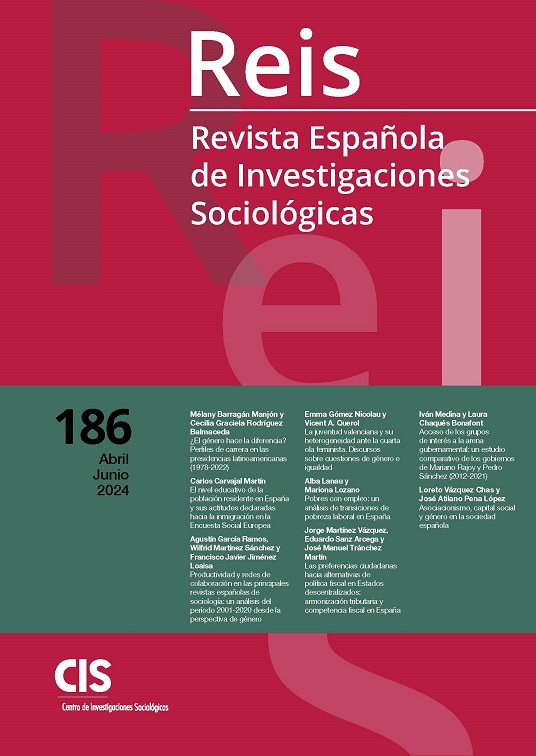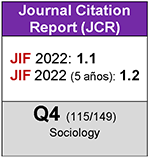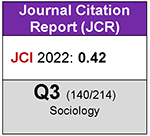The Education Level of the Spanish Resident and Stated Attitudes toward Immigration in the European Social Survey
DOI:
https://doi.org/10.5477/cis/reis.186.25-42Keywords:
Bivariate Analysis, Multivariate Analysis, Classification Tree, European Social Survey , Immigration, Education Level, Family OriginsAbstract
The present study uses a quantitative approach to analyse the relationship between education level and stated attitudes toward immigration among the Spanish resident. Data from the European Social Survey (ESS) has been analysed using three quantitative
techniques: bivariate analysis, segmentation and multiple linear regression. Results confirm the association between both variables, albeit influenced by family origin and with an intensity below expected in comparison with other intervening factors.
Downloads
References
Alesina, Alberto; Miano, Armando y Stantcheva, Stefanie (2023). «Immigration and redistribution». The Review of Economic Studies, 90(1): 1-39. DOI: https://doi.org/10.1093/restud/rdac011
Aparicio, Rosa y Portes, Alejandro (2014). Crecer en España: la integración de los hijos de inmigrantes. Obra Social "La Caixa".
Cea D'Ancona, Ángeles (2005). «La senda tortuosa de la “calidad” de la encuesta». Revista Española de Investigaciones Sociológicas, 111(1): 75-103. DOI: https://doi.org/10.2307/40184700
Cea D'Ancona, Ángeles (2009). «La compleja detección del racismo y la xenofobia a través de encuesta. Un paso adelante en su medición». Revista Española de Investigaciones Sociológicas, 125(1): 13-45. DOI: https://doi.org/10.5477/cis/reis.125.13
Consejo Económico y Social de España (2019). La inmigración en España: efectos y oportunidades. Colección Informes CES, 02/2019.
Escobar, Modesto (1998). «Las aplicaciones del análisis de segmentación: el procedimiento Chaid». EMPIRIA. Revista de Metodología de Ciencias Sociales, 1: 13-49.
Escribano, Antonio I. (2014). «Balance del mundo que hemos aprendido: tres décadas de experiencia migratoria en España». Mientras Tanto, (122/123): 161-188.
Finseraas, Henning; Skorge, Øyvind S. y Strøm, Marte (2018). «Does Education Affect Immigration Attitudes? Evidence from an Education Reform». Electoral Studie, 55: 131-135. DOI: https://doi.org/10.1016/j.electstud.2018.06.009
Hainmueller, Jens y Hiscox, Michael J. (2007). «Educated Preferences: Explaining Attitudes toward Immigration in Europe». International Organization, 61(2): 399-442. DOI: https://doi.org/10.1017/S0020818307070142
Hainmueller, Jens y Hopkins, Daniel J. (2014). «Public Attitudes toward Immigration». Annual Review of Political Science, 17: 225-249. DOI: https://doi.org/10.1146/annurev-polisci-102512-194818
Heath, Anthony; Davidov, Eldad; Ford, Robert; Green, Eva G.; Ramos, Alice y Schmidt, Peter (2020). «Contested Terrain: Explaining Divergent Patterns of Public Opinion towards Immigration within Europe». Journal of Ethnic and Migration Studies, 46(3): 475-488. DOI: https://doi.org/10.1080/1369183X.2019.1550145
Heppell, Timothy; Crines, Andrew y Jeffery, David (2017). «The United Kingdom Referendum on European Union Membership: The Voting of Conservative Parliamentarians». JCMS: Journal of Common Market Studies, 55(4): 762-778. DOI: https://doi.org/10.1111/jcms.12529
Kinovich, Robert M. (2004). «Social Structural Position and Prejudice: An Exploration of Cross-national Differences in Regression Slopes». Social Science Research, 33(1): 20-44. DOI: https://doi.org/10.1016/S0049-089X(03)00037-1
Margaryan, Shushanik; Paul, Annemarie y Siedler, Thomas (2021). «Does Education Affect Attitudes towards Immigration? Evidence from Germany». Journal of Human Resources, 56(2): 446-479. DOI: https://doi.org/10.3368/jhr.56.2.0318-9372R1
Maxwell, Rahsaan (2010). «Evaluating Migrant Integration: Political Attitudes across Generations in Europe». International Migration Review, 44(1): 25-52. DOI: https://doi.org/10.1111/j.1747-7379.2009.00797.x
McLaren, Lauren y Paterson, Ian (2020). «Generational Change and Attitudes to Immigration». Journal of Ethnic and Migration Studies, 46(3): 665-682. DOI: https://doi.org/10.1080/1369183X.2018.1550170
Ministerio de Educación y Formación Profesional (2023). Sistema Estatal de Indicadores de la Educación. Madrid: Instituto Nacional de Evaluación Educativa. Secretaria General Técnica.
OECD Publishing (2013). International Migration Outlook 2013. OECD Publishing.
Persson, Mikael (2015). «Education and Political Participation». British Journal of Political Science, 45(3): 689-703. DOI: https://doi.org/10.1017/S0007123413000409
Portes, Alejandro y Rivas, Alejandro (2011). «The Adaptation of Migrant Children». The Future of Children, 21(1): 219-246. DOI: https://doi.org/10.1353/foc.2011.0004
Riba, Clara; Torcal, Mariano y Morales, Laura (2010). «Estrategias para aumentar la tasa de respuesta y los resultados de la Encuesta Social Europea en España». Revista Internacional de Sociología, 68(3): 603-635. DOI: https://doi.org/10.3989/ris.2008.12.17
Roots, Ave; Masso, Anu y Ainsaar, Mare (2016). «Measuring Attitudes towards Immigrants: Validation of Immigration Attitude Index across Countries». European Social Survey Conference.
Semyonov, Moshe; Raijman, Rebeca y Gorodzeisky, Anastasia (2008). «Foreigners' Impact on European Societies: Public Views and Perceptions in a Cross-national Comparative Perspective». International Journal of Comparative Sociology, 49(1): 5-29. DOI: https://doi.org/10.1177/0020715207088585
Valdés, Manuel T. (2020). «Efectos primarios y secundarios del origen social en la transición a la educación posobligatoria en España». Revista Española de Investigaciones Sociológicas, 171: 125-144. DOI: https://doi.org/10.5477/cis/reis.171.125
Waal, Jeroen van der; Achterberg, Peter; Houtman, Dick; Koster, Willem de y Manevska, Katerina (2010). «“Some Are More Equal than Others”: Economic Egalitarianism and Welfare Chauvinism in the Netherlands». Journal of European Social Policy, 20(4): 350-363. DOI: https://doi.org/10.1177/0958928710374376
Wooldridge, Jeffrey M. (2015). Introductory Econometrics: A Modern Approach. Ohio: South-Western. Cengage Learning.
Downloads
Published
How to Cite
Issue
Section
License
Copyright (c) 2023 Revista Española de Investigaciones Sociológicas

This work is licensed under a Creative Commons Attribution-ShareAlike 4.0 International License.
Permite Compartir — copiar y redistribuir el material en cualquier medio o formato, Adaptar — remezclar, transformar y construir a partir del material para cualquier propósito, incluso comercialmente.








